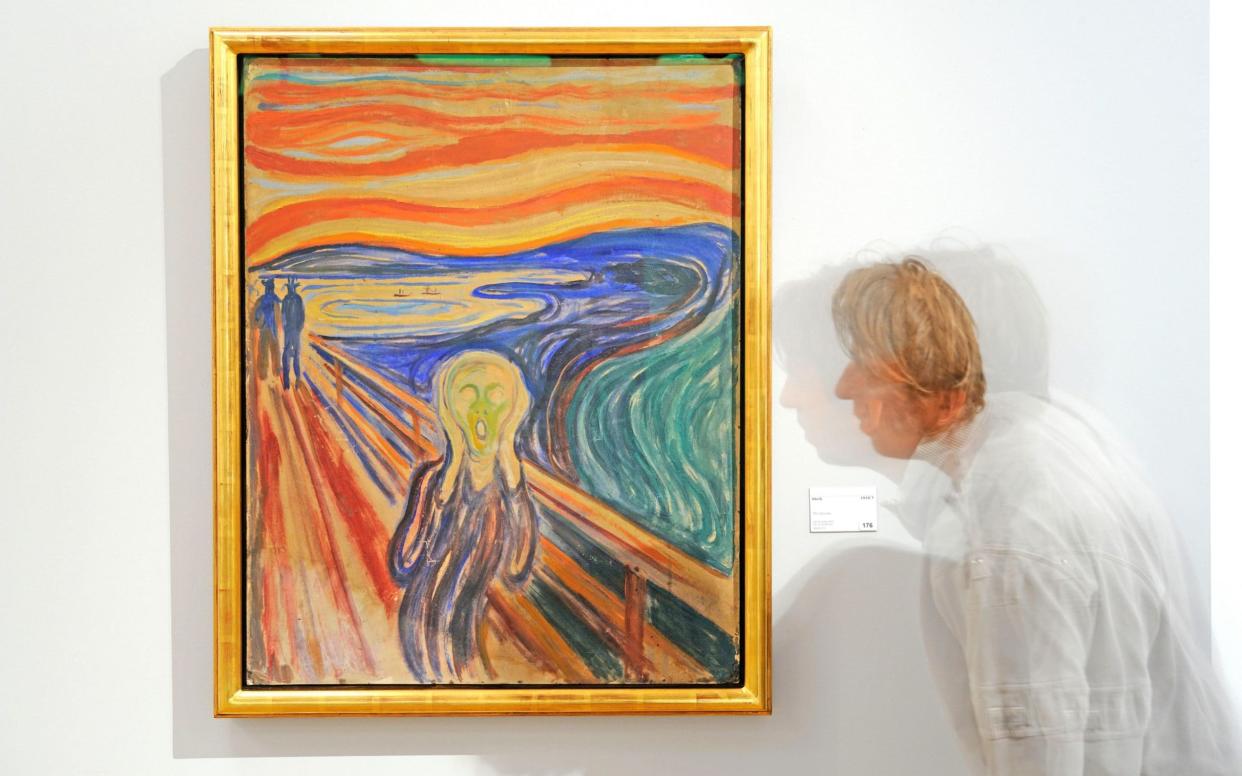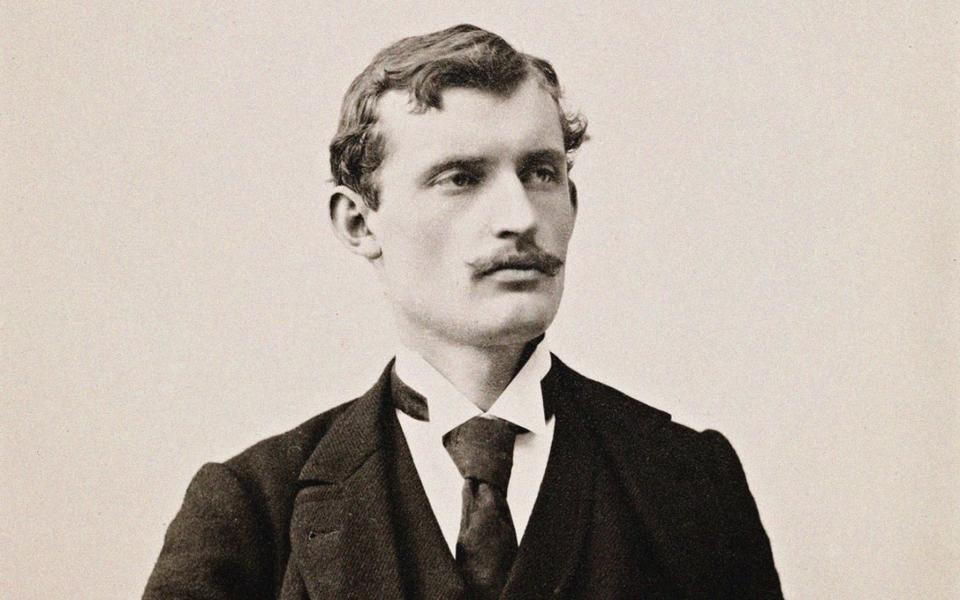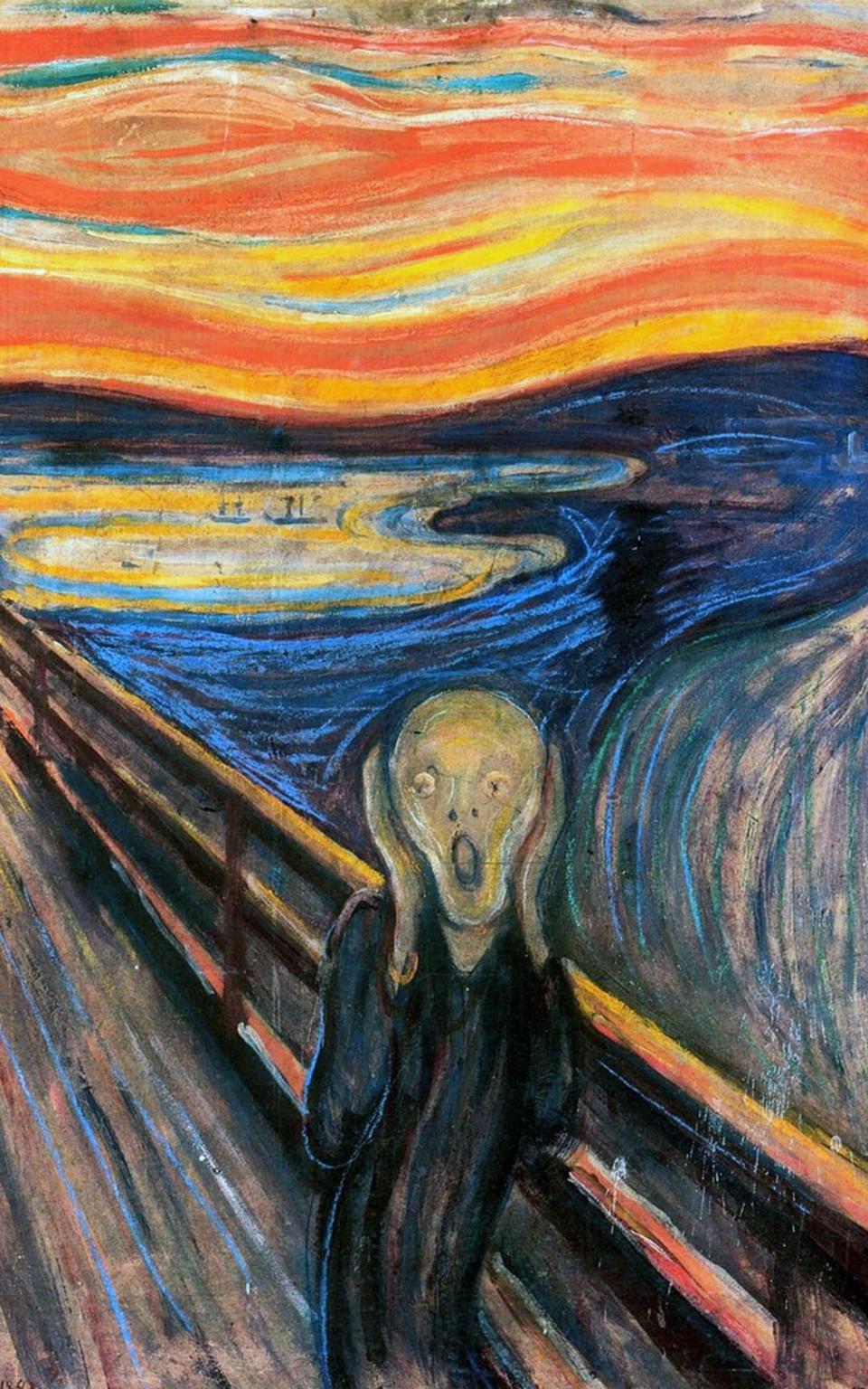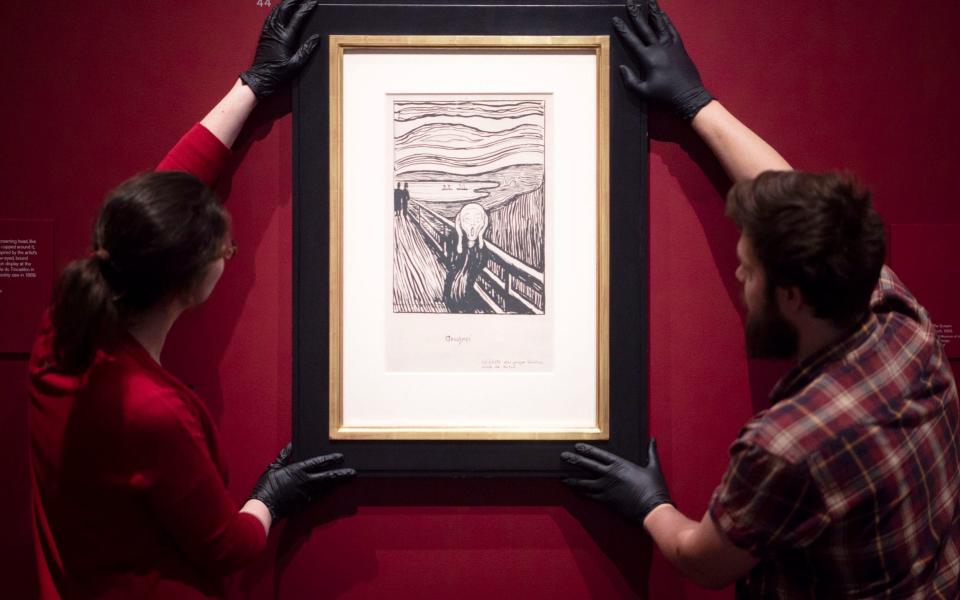Reviled, stolen, held hostage for chocolate: the bizarre history of Munch’s The Scream

- Oops!Something went wrong.Please try again later.
Even if you don’t know The Scream, you know The Scream. In the century since Norwegian artist Edvard Munch produced his most famous work, its mouth-gaping, head-clutching central image has become a universal shorthand for existential angst.
But this week, the solution to an enduring mystery surrounding the painting has prompted a reassessment of the artist’s relationship to his own work. A conservation project at the National Museum of Norway has revealed that a line of what was thought to be graffiti on the canvas of the earliest version of the painting was actually written by the artist himself. Infrared scanning has matched the tiny letters in “can only have been painted by a madman”, a phrase written in Norwegian that can just be glimpsed in the upper left corner of the Museum’s 1893 canvas, with surviving samples of Munch’s handwriting.
The discovery reinforces our understanding of the fraught critical atmosphere that greeted the unveiling of The Scream in Oslo in 1895. It debunks the traditional theory that it was the graffiti of an irate critic (straying beyond his brief), and if reframed as a satirical commentary from the besieged artist himself, it gives a sense of just how affected Munch was by the intensely personal criticism of his painting from the artistic establishment.
A lecture accompanying the debut in 1895 condemned the artist as a “most insane man”; it is this pronouncement to which, it’s thought, Munch’s line was written in response. The comment had a particularly vicious sting given the artist’s family history of mental illness, and also given that it came not from an art critic, but a medical student. According to the Museum’s curator, Mai Britt Guleng, Munch was seen in the room “standing pale against the wall” during the lecture.
Given The Scream’s remarkable assimilation into mainstream popular culture today – it turns up everywhere from your phone’s emoji library to cult Nineties slasher films – it’s easy to overlook its strange and tempestuous history in the public eye. Indeed, so total has Munch’s absorption into consumer culture become that the Nordic cruise conglomerate Viking now boasts the largest private collection of his art outside of Oslo: it owns 28 pieces, which it displays on its liners.

Yet controversy has always surrounded The Scream. In the late 1930s, Munch’s work was declared “degenerate” by the Nazis, and it was only through the efforts of a shipping magnate named Thomas Olsen, a friend and patron of Munch, that the majority of his works weren’t destroyed. In 1937, Olsen struck a deal with the Nazi government to ensure the safe removal of 74 Munch paintings from Germany, while his personal collection, including one version of The Scream, was hidden in a hay barn in central Norway for the entirety of the war.
Even the basic facts of the painting have long been in contention: what is it called and what does it show? The original German title given to the painting by Munch was Der Schrei der Natur, which translates as “The Scream of Nature”, while the Norwegian title is Skrik, or “Shriek”. In a poem Munch painted onto the frame of one version of the work, he describes his inspiration for the painting as a “great scream in Nature”; given the position of the figure’s hands, which seem to be clamped over their ears, we might deduce that the painting shows someone reacting to the sound of a scream, rather than giving one themselves.
Debates over its meaning continue to this day. The modern consensus, summed up by art critic Philip Hook, in a catalogue accompanying the 2012 sale of one version of the painting, is that it is “the ultimate embodiment of fear, angst and alienation.” But some critics, uneasy with such a broad and impersonal interpretation, have linked the emotion in the painting to Munch’s own biography. The location of the scene the painting depicts, on a hill overlooking Oslo, is close to a mental asylum where his sister Laura Catherine, who suffered from severe depression, was confined at the time, and some have suggested the agonised figure represents Munch’s response to her plight.
Still others have suggested it depicts some specific environmental phenomenon: in the lines describing his inspiration, Munch says he was out walking with friends near Oslo when he saw “the sky [turning] blood red” and “blood and tongues of fire above the blue-black fjord and the city.” On the basis of this description, some have speculated that what he witnessed was the volcanic eruption of Krakatoa, which tinted skies red in parts of the West for months during 1883 and 1884, and that the painting was a response to that memory.

Perhaps it isn’t surprising that viewers have struggled to arrive at one conclusive interpretation of a painting that exists in multiple versions. Munch created four different variants of The Scream, two in paint and two in pastel. The one on display in the National Museum of Norway, with that “graffiti”, is painted, and the earliest of the four. A pastel version also created in 1893, which may have been a preliminary study, is in the collection of the Munch Museum, also in Oslo, along with the second painted version from 1910, produced during a period when Munch revisited some of his prior compositions. The second pastel version, from 1895, was sold in 2012 for nearly $120 million (£75 million) at Sotheby’s, to financier Leon Black. (Munch also created a lithograph stone of the composition in 1895, from which several prints survive, although the stone was later resurfaced by the printer.)
Four versions of one extremely famous painting means four times the opportunities for theft – over the years, The Scream has proved a magnet for art thieves. On February 12 1994, the same day as the opening of the Winter Olympics in Lillehammer, two men broke into the National Museum of Norway and stole its version of The Scream, leaving a note reading “Thanks for the poor security”. (The painting had been moved down to a second-story gallery as part of the Olympic festivities.)
After the gallery refused to pay a ransom demand of $1 million, Norwegian police set up a sting operation with assistance from the British police and the Getty Museum, and recovered the painting undamaged on May 7 that year. Four men were convicted in connection with the theft, including Pål Enger, who had already been convicted of stealing another Munch painting, Vampire, in 1988. But they were all subsequently released on appeal, after it was shown that the British agents involved in the sting operation had entered Norway under false identities.

The 1910 version of The Scream was stolen on August 22 2004, during daylight hours, when masked gunmen entered the Munch Museum. Madonna, another Munch painting, was also taken. Despite the fact that the robbers were photographed by a bystander as they made their escape, and that the three men were subsequently convicted in May 2006, the paintings were not recovered until August of that year. The Norwegian police did not release details of the recovery, apart from to confirm their authenticity and that the damage incurred was far less severe than expected.
So how did they find them? Speaking to ArtNews in 2008, Charles Hill, a former member of Scotland Yard’s Art and Antiques Unit, recalled a rumour that an imprisoned armed robber had turned informant and struck a deal with the police. “I heard that after he was convicted and sentenced to 20 years, his lawyer said to the cops that in return for conjugal rights with his girlfriend and a published reward of two million M&M’s, he’d arrange to have the pictures returned. He reckoned he could go through the two million in 20 years.”
What is certainly true is that in 2006, after launching a new ad campaign at the Guggenheim Museum, M&M’s announced that it was offering a reward of two million of their new dark-chocolate M&M’s for the return of The Scream. According to the confectionery conglomerate, the reward eventually went to the police, not the sugar-happy prisoner, and was delivered in the form of 140,000 Norwegian kroner, or about $24,000, which is how much the M&M haul would be worth. (Apparently there were logistical objections to shipping 40,000 bags of M&Ms to Oslo’s police HQ.)
Now it seems that the last laugh (or wail) goes to Munch himself, even if it did take the form of a drunken scrawl on his own masterpiece. On the other hand, so long as priceless paintings cover the walls of cruise ships, and opportunist art thieves have sugar cravings, it might be premature to declare that, when it comes to The Scream, this is where the story ends.

